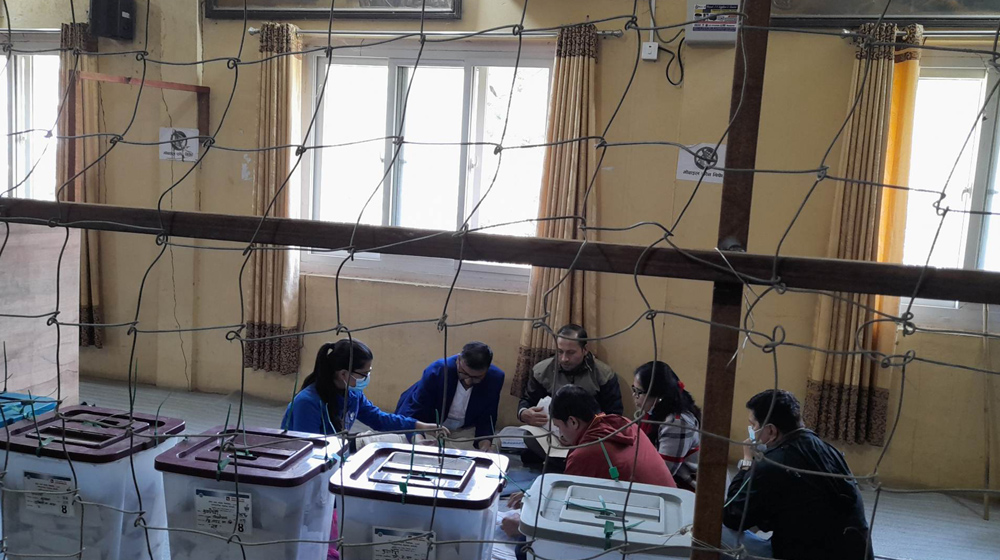

Counting begins in Nepal’s national polls
Only 61 per cent eligible voters polled in Sunday’s elections, but the turnout could have been even lower had young candidates had not been in the fray.
According to the country’s Election Commission, the average voter turnout in Sunday’s general elections stood at 61 percent. This is the lowest ever voter turnout since the country held the first Constituent Assembly elections in 2008.
“Of the 17.98 million registered voters, only 61 percent cast their ballots in today’s elections. Certainly, less than what we had expected. However, it may go up by a few percentage points in the final tally,” Dinesh Thapaliya, chief election commissioner, said.
Nepal on Sunday held federal parliament and provincial assembly elections simultaneously across the country.
Analysts say that voter turnout would have been even lower had young candidates not contested the polls. A significant number of youngsters were in the fray in these elections. Sobita Gautam, Toshima Karki, Abdus Miya and Sagar Dhakal are some of the new faces who contested elections with the older politicians.
Gautam is in a tough battle with Onsari Gharti, a former speaker of parliament while Karki is taking on Pamfa Bhusal, the incumbent energy minister. Likewise, Miya is contesting with the Maoist Chairman Prachanda while Dhakal is locking horns with none other than Sher Bahadur Deuba, the prime minister.
Out of a total of 275 members of the federal Parliament, 165 were elected through direct voting (first-past-the-post) and the remaining 110 were elected through proportional representation (PR) category.
Similarly, out of a total of 550 members of the provincial legislatures, 330 were elected directly and 220 were elected through the PR system.
According to the Election Commission of Nepal, elections were largely peaceful except for a few sporadic incidents in some places.
This was the second time Nepalis voted for the House of Representatives (HoR) and provincial assembly elections after the promulgation of the constitution in 2015. Earlier, similar polls were held in 2017.
Kathmandu Post, Nepal’s leading daily newspaper has presented the history of voter turnout during elections since 1959.
In the 1959 elections, 42.18 percent votes were cast. In 1991, the voter turnout was 65.14 percent; in the 1994 snap elections, 61.86 percent voters exercised their franchise; and the 1999 vote recorded a 65.79 percent attendance.
In the first Constituent Assembly (CA) elections, 61.70 percent and 63.29 percent votes were cast under the FPTP and PR categories, respectively. In the second CA elections, voter participation was 78.74 percent under the FPTP category and 79.82 percent under the proportional representation category. In the 2017 polls, the turnout stood at 68.66 percent.
Two broad alliances
There were two broad electoral alliances in the elections. The ruling alliance led by the ruling Nepali Congress had communist parties—CPN (Maoist Center), CPN (Unified Socialist) and a Madhes-centric party Loktantrik Samajbadi Party (LSP) its members.
The other alliance was led by CPN (UML) in which monarchist and Hindu nationalist Rashtriya Prajantantra Party led by Kamal Thapa and Madhes-centric Janata Samajwadi Party (JSP) led by Upendra Yadav were major allies.
Factors behind drop in voter turnout
Several factors contributed to the significant drop in the voter turnout in elections, experts say.
The committed cadres of the parties seem to have skipped voting in those electoral constituencies where there were no candidates from their own party.
Another reason is that candidates seem to have failed to motivate eligible voters to cast ballots as they lacked people-oriented agendas.
The growing use of social media also could have demotivated young voters to cast ballots as they perceive traditional parties as incompetent and inefficient.
Voters confused as parties did not contest polls in ideological platforms
Akhilesh Upadhaya, a political commentator and a former editor-in-chief of Kathmandu Post newspaper, described the present election as the least ideological parliamentary election that Nepal witnessed in its parliamentary history.
“Major parties this time didn’t contest elections on ideological platforms. Voters, especially in urban hubs where the number of middle-class and educated people is high, did not know whom they were going to vote for and what they were getting by doing so. There was a serious disconnect between the political parties and the voters,” he told India Narrative on Monday.
According to Upadhaya, the low voter turnout also reflects growing resentment of the younger population towards alliance politics.
“New parties like Rashtriya Swantantra Party led by former TV anchor Ravi Lamchhane are making electoral gains in urban areas like Pokhara, Chitwan and Kathmandu where the number of middle-class and educated people is very high,” he observed.
Vote counting begins
Vote counting has kicked off in several constituencies on Monday. The early vote counting shows traditional parties like the Nepali Congress and the UML will make significant political grounds. However, new parties like Rashtriya Swantantra Party led by former TV anchor Ravi Lamchhane are also likely to gain significant electoral gains in urban areas including Pokhara, Chitwan and Kathmandu.
Taiwan's military is prioritising combat readiness as a key aspect of deterrence due to escalating…
Calling for an increase in the speed of development, Prime Minister Narendra Modi said on…
The Scottish Government has reaffirmed its commitment to supporting religious freedom and human rights for…
Tara Chand Baloch, the President of the Baloch American Congress and a former Cabinet minister…
In a groundbreaking study, researchers from McGill University have identified nine biological markers in the…
India, in a firm and unequivocal statement at the United Nations Security Council (UNSC), accused…